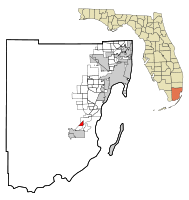- Naranja, Florida
-
Naranja, Florida — CDP — Location in Miami-Dade County and the state of Florida U.S. Census Bureau map showing CDP boundaries Coordinates: 25°31′N 80°25′W / 25.517°N 80.417°WCoordinates: 25°31′N 80°25′W / 25.517°N 80.417°W Country  United States
United StatesState  Florida
FloridaCounty Miami-Dade Area - Total 1.6 sq mi (4.3 km2) - Land 1.5 sq mi (3.9 km2) - Water 0.1 sq mi (0.4 km2) Elevation 7 ft (2 m) Population (2000) - Total 4,034 - Density 2,521.3/sq mi (938.1/km2) Time zone Eastern (EST) (UTC-5) - Summer (DST) EDT (UTC-4) ZIP codes 33032, 33033, 33092 Area code(s) 305 FIPS code 12-47700[1] GNIS feature ID 0287532[2] Naranja is a census-designated place (CDP) in Miami-Dade County, Florida, United States. Many orange groves were once located in this area, so the community name came from the Spanish word for orange, "naranja". Naranja was also a stop for the Florida East Coast Railroad that once ran through this area. The population was 4,034 at the 2000 census.
Geography
Naranja is located at 25°31′N 80°25′W / 25.517°N 80.417°W (25.5174, -80.4217)[3].
According to the United States Census Bureau, the CDP has a total area of 1.7 square miles (4.4 km2), of which, 1.5 square miles (3.9 km2) of it is land and 0.2 square miles (0.52 km2) of it (8.98%) is water.
Demographics
Historical populations Census Pop. %± 1960 2,309 — 1990 5,790 — 2000 4,034 −30.3% source:[4][5][6] As of the census[1] of 2000, there were 4,034 people, 1,196 households, and 875 families residing in the CDP. The population density was 2,654.6 people per square mile (1,024.7/km²). There were 1,630 housing units at an average density of 1,072.7/sq mi (414.0/km²). The racial makeup of the CDP was 32.99% White (of which 12.7% were Non-Hispanic Whites,)[7] 57.54% African American, 0.42% Native American, 1.39% Asian, 0.15% Pacific Islander, 3.89% from other races, and 3.62% from two or more races. Hispanic or Latino of any race were 26.97% of the population.
There were 1,196 households out of which 48.7% had children under the age of 18 living with them, 30.4% were married couples living together, 36.0% had a female householder with no husband present, and 26.8% were non-families. 20.6% of all households were made up of individuals and 5.9% had someone living alone who was 65 years of age or older. The average household size was 3.23 and the average family size was 3.73.
In the CDP the population was spread out with 39.5% under the age of 18, 11.3% from 18 to 24, 27.8% from 25 to 44, 14.0% from 45 to 64, and 7.4% who were 65 years of age or older. The median age was 24 years. For every 100 females there were 90.6 males. For every 100 females age 18 and over, there were 82.7 males.
The median income for a household in the CDP was $18,825, and the median income for a family was $19,443. Males had a median income of $22,614 versus $19,167 for females. The per capita income for the CDP was $7,346. About 42.3% of families and 50.5% of the population were below the poverty line, including 62.7% of those under age 18 and 19.8% of those age 65 or over.
As of 2000, speakers of English as a first language accounted for 66.25% of residents, while Spanish made up 28.14%, French Creole was at 4.64%, and Tagalog was the mother tongue of 0.95% of the population.[8]
As of 2000, Naranja had the highest percentage of Trinidadian and Tobagonian residents in the US, with 2.70% of the populace (tied with Lakeview, NY.)[9] It had the sixty-first highest percentage of Cuban residents in the US, at 5.90% of the population,[10] and the forty-second highest percentage of Haitian residents in the US, at 4.30% of its population.[11] It also had the thirty-fifth most Jamaicans in the US, at 3.80% (tied with the borough of Brooklyn, NY and Stone Mountain, GA,)[12] while it had the thirty-third highest percentage of Nicaraguans, at 1.26% of all residents (tied with San Bruno, California.)[13]
References
- ^ a b "American FactFinder". United States Census Bureau. http://factfinder.census.gov. Retrieved 2008-01-31.
- ^ "US Board on Geographic Names". United States Geological Survey. 2007-10-25. http://geonames.usgs.gov. Retrieved 2008-01-31.
- ^ "US Gazetteer files: 2010, 2000, and 1990". United States Census Bureau. 2011-02-12. http://www.census.gov/geo/www/gazetteer/gazette.html. Retrieved 2011-04-23.
- ^ "CENSUS OF POPULATION AND HOUSING (1790-2000)". U.S. Census Bureau. http://www.census.gov/prod/www/abs/decennial/index.html. Retrieved 2010-07-31.
- ^ Not enumerated separately in 1970.
- ^ In 1980, Naranja combined with Princeton to form Naranja-Princeton CDP, which enumerated a population of 10,381.
- ^ "Demographics of Naranja, FL". MuniNetGuide.com. http://www.muninetguide.com/states/florida/municipality/Naranja.php. Retrieved 2007-11-07.
- ^ "MLA Data Center Results of Naranja, FL". Epodunk.com. http://www.mla.org/map_data_results&state_id=12&county_id=&mode=place&zip=&place_id=47700&cty_id=&ll=&a=&ea=&order=r. Retrieved 2007-11-07.
- ^ "Ancestry Map of Trinidadian & Tobagonian Communities". Epodunk.com. http://www.epodunk.com/ancestry/Trinidadian-Tobagonian.html. Retrieved 2007-11-07.
- ^ "Ancestry Map of Cuban Communities". Epodunk.com. http://www.epodunk.com/ancestry/Cuban.html. Retrieved 2007-11-07.
- ^ "Ancestry Map of Haitian Communities". Epodunk.com. http://www.epodunk.com/ancestry/Haitian.html. Retrieved 2007-11-07.
- ^ "Ancestry Map of Jamaican Communities". Epodunk.com. http://www.epodunk.com/ancestry/Jamaican.html. Retrieved 2007-11-07.
- ^ "Ancestry Map of Nicaraguan Communities". Epodunk.com. http://www.epodunk.com/ancestry/Nicaraguan.html. Retrieved 2007-11-07.
Categories:- Census-designated places in Miami-Dade County, Florida
- Populated places in Florida with African American majority populations
Wikimedia Foundation. 2010.



